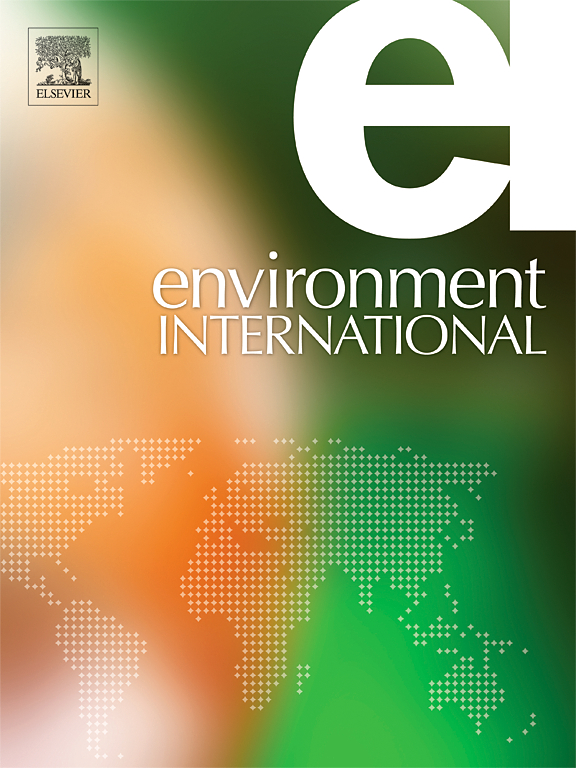Ambient fine particulate matter provokes multiple modalities of cell death via perturbation of subcellular structures
IF 9.7
1区 环境科学与生态学
Q1 ENVIRONMENTAL SCIENCES
引用次数: 0
Abstract
Fine particulate matter (PM2.5) is increasingly recognized for its detrimental effects on human health, with substantial evidence linking exposure to various forms of cell death and dysfunction across multiple organ systems. This review examines key cell death mechanisms triggered by PM2.5, including PANoptosis, necroptosis, autophagy, and ferroptosis, while other forms such as oncosis, paraptosis, and cuprotosis remain unreported in relation to PM2.5 exposure. Mitochondria, endoplasmic reticulum, and lysosomes emerge as pivotal organelles in the disruption of cellular homeostasis, with mitochondrial dysfunction particularly implicated in metabolic dysregulation and the activation of pro-apoptotic pathways. Although PM2.5 primarily affects the nucleus, cytoskeleton, mitochondria, endoplasmic reticulum, and lysosomes, other organelles like ribosomes, Golgi apparatus, and peroxisomes have received limited attention. Interactions between these organelles, such as endoplasmic reticulum-associated mitochondrial membranes, lysosome-associated mitophagy, and mitochondria-nuclei retro-signaling may significantly contribute to the cytotoxic effects of PM2.5. The mechanisms of PM2.5 toxicity, encompassing oxidative stress, inflammatory responses, and metabolic imbalances, are described in detail. Notably, PM2.5 activates the NLRP3 inflammasome, amplifying inflammatory responses and contributing to chronic diseases. Furthermore, PM2.5 exposure disrupts genetic and epigenetic regulation, often resulting in cell cycle arrest and exacerbating cellular damage. The composition, concentration, and seasonal variability of PM2.5 modulate these effects, underscoring the complexity of PM2.5-induced cellular dysfunction. Despite significant advances in understanding these pathways, further research is required to elucidate the long-term effects of chronic PM2.5 exposure, the role of epigenetic regulation, and potential strategies to mitigate its harmful impact on human health.
环境细颗粒物通过对亚细胞结构的扰动引起多种形式的细胞死亡
细颗粒物(PM2.5)对人体健康的有害影响日益得到承认,有大量证据表明,接触细颗粒物会导致多种形式的细胞死亡和多个器官系统的功能障碍。本综述研究了PM2.5引发的关键细胞死亡机制,包括PANoptosis、necroptosis、autophagy和ferroptosis,而其他形式的肿瘤、细胞凋亡和cuprotosis仍未报道与PM2.5暴露有关。线粒体、内质网和溶酶体是破坏细胞稳态的关键细胞器,线粒体功能障碍特别涉及代谢失调和促凋亡途径的激活。虽然PM2.5主要影响细胞核、细胞骨架、线粒体、内质网和溶酶体,但其他细胞器如核糖体、高尔基体和过氧化物酶体受到的关注有限。这些细胞器之间的相互作用,如内质网相关的线粒体膜、溶酶体相关的线粒体自噬和线粒体核逆转录信号传导,可能会显著促进PM2.5的细胞毒性作用。详细描述了PM2.5毒性的机制,包括氧化应激、炎症反应和代谢失衡。值得注意的是,PM2.5激活NLRP3炎性体,放大炎症反应,导致慢性疾病。此外,PM2.5暴露会破坏遗传和表观遗传调控,往往导致细胞周期停滞,加剧细胞损伤。PM2.5的成分、浓度和季节变化调节了这些影响,强调了PM2.5诱导的细胞功能障碍的复杂性。尽管在了解这些途径方面取得了重大进展,但仍需要进一步研究来阐明慢性PM2.5暴露的长期影响、表观遗传调控的作用以及减轻其对人类健康有害影响的潜在治疗策略。
本文章由计算机程序翻译,如有差异,请以英文原文为准。
求助全文
约1分钟内获得全文
求助全文
来源期刊

Environment International
环境科学-环境科学
CiteScore
21.90
自引率
3.40%
发文量
734
审稿时长
2.8 months
期刊介绍:
Environmental Health publishes manuscripts focusing on critical aspects of environmental and occupational medicine, including studies in toxicology and epidemiology, to illuminate the human health implications of exposure to environmental hazards. The journal adopts an open-access model and practices open peer review.
It caters to scientists and practitioners across all environmental science domains, directly or indirectly impacting human health and well-being. With a commitment to enhancing the prevention of environmentally-related health risks, Environmental Health serves as a public health journal for the community and scientists engaged in matters of public health significance concerning the environment.
 求助内容:
求助内容: 应助结果提醒方式:
应助结果提醒方式:


